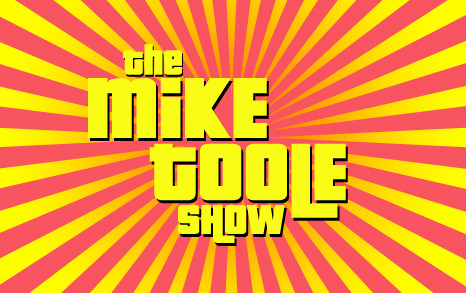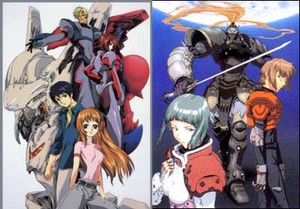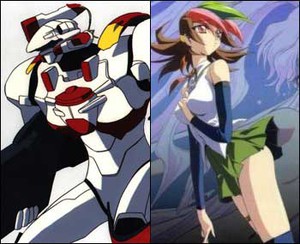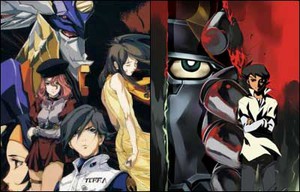The Mike Toole Show
Evangel-a-like
by Michael Toole,
I learned something interesting this week. Evangelion 2.22, the orange-jacketed second installment of the seemingly eternally popular SF psychodrama, is well into six-figure sales numbers at Best Buy alone. This isn't surprising, really - while the series wrapped up in 1996 and the follow-up movies were done in '98, the videos, DVDs, and other associated merchandise never really went away. Sometimes I do wonder, as director Hideaki Anno works tirelessly on resurrecting his magnificent beast of an anime franchise, if anyone still give a damn - but the success of this release pretty neatly puts my wonders to rest.
Evangelion was unquestionably one of the most important anime of the 1990s, right up there with Utena, Serial Experiments Lain, Cowboy Bebop, Trigun, and all of those other shows that are allegedly better than what's on TV these days. The series was broadly popular here in North America, where its cool imagery, fresh character and mecha designs, and unabashedly complex and ambiguous storyline really put the medium on the map. Just weeks after its Japanese TV debut, the series was already getting talked about in outlets like WIRED magazine. But if it was big here, it was huge in Japan, where the show was a TV ratings champ and graced the cover of Newsweek. The show and its immensely talented staff would help shape the direction of the entire industry moving forward, and that's what I want to touch on. I'm not going to focus on how Evangelion might've influenced merchandising or production - that's a tough nut to crack indeed. Instead, I'm going to look at ten anime series that were so obviously influenced by what Evangelion was that they couldn't have happened without it.


Brain Powered seems like an obvious first choice. See, much has been made of the fact that Evangelion takes cues from a number of beloved sources, like Ultraman and Space Runaway Ideon. Hideaki Anno has been pretty vocal about Ideon's influence on Evangelion, actually, so it didn't come as much of a surprise when Sunrise positioned Gundam grandmaster Yoshiyuki Tomino to topple Anno, with a high-concept, high-budget mecha anime of his own, his first TV series since the hot-and-cold V Gundam. Tomino really talked the connection up, too - ever the showman, he promised big things, saying that Brain Powered would go as far as Evangelion - and farther! The effort certainly shows in the series, which features some of the most jaw-droppingly gorgeous production design I've seen in modern TV anime - everything from Mamoru Nagano's fanciful and weird "antibody" mecha to Mutsumi Inomata's striking, evocative character designs to Yoko Kanno's immense musical score was right on target. Unfortunately, Tomino's wild-card approach to storytelling and the show's confused jumble of characters and messages fell a little short. Both the TV series and manga were published in their entirety in North America, and remain pretty easy to find, though out of print.
Then there's Gasaraki. Produced by Sunrise and helmed by mecha anime great Ryousuke Takahashi, it debuted on Japanese TV in 1998 and came to the US via ADV Films less than a year later. The show is much more grounded than Evangelion, replacing its scary and inscrutable alien invaders with a relatively ordinary conflict between the US and a fictional middle-eastern country. A Japanese business dynasty, the Gowa family, uses this conflict to demonstrate its new, fearsome, and mysterious TA (tactical armor) vehicles. What gives the series a tie-up to Evangelion, though? I reckon it'd be two things - the TAs are realistic and cool-looking, but they have their basis as much in mysticism as they do in technology. (The story behind it is legitimately pretty cool, so I won't spoil it further than that.) The other thing is Miharu, a pale, lavender-haired, waifish mecha pilot who doesn't talk much. Sound familiar? Google up some promotional artwork for more laughs - the show's character designer is Shuko Murase, but his work is more pointed and similar to Evangelion's Yoshiyuki Sadamoto than most of the rest of his work. Interestingly, Gasaraki was a pretty big deal when it first debuted, but it's sank without a trace in recent years - it's not even in print on DVD anymore.
Of course, Brain Powered and Gasaraki played it cool - the influences Evangelion had on them were as much about storytelling and structure as they were about characters and robots. Dual! Parallel Trouble Adventure, on the other hand, is just about as uncouth a ripoff as you could imagine, at least visually. Produced by AIC in 1999 and directed by Katsuhiko Akiyama, the show gleefully and shamelessly steals its mecha and character archetypes almost note-for-note from Evangelion. The show's Core Robots look and move almost exactly like Eva units; series hero Kazuki is the only male who can control them. The harem of girls around him include a striking but bossy schoolmate, an experienced older gal smitten after he rescues her, and a pale, nearly silent girl with freakishly green hair. Happily, Dual makes no bones about being a comedic takeoff, and is a lighthearted, smart little escapade about two parallel worlds smashing together. To stoke the flames of controversy, original creator Masaki Kajishima said in a magazine interview that Dual's universe is actually a parallel continuity of his own Tenchi Muyo! I'd like to see Tenchi pilot an Eva-- er, Core Robot. Dual was pretty popular in its day, but it too has faded.
 Most of the shows in this little list aren't bad at all. De:vadasy is. A 3-episode OVA produced by AIC at the same time as Dual, it follows the formula of the callow, uncertain boy pilot and his two hot girlfriend pilots. Once again, the robots look awfully similar to Eva units, and the bad guys are city-smashing leviathans from another world. The hook, this time, is that the robots must be piloted by both the boy (Kei) and one of the girls together - and piloting the things has weird, creepily sexual psychic feedback. The show was heavy enough on suggestive dialogue and (mostly offscreen) sexual content that AIC actually changed their posture at release time and targeted it as a "risque" adults-only title. It's cheap, shoddy, and you can find it on DVD for a dollar or two. That's still too much!
Most of the shows in this little list aren't bad at all. De:vadasy is. A 3-episode OVA produced by AIC at the same time as Dual, it follows the formula of the callow, uncertain boy pilot and his two hot girlfriend pilots. Once again, the robots look awfully similar to Eva units, and the bad guys are city-smashing leviathans from another world. The hook, this time, is that the robots must be piloted by both the boy (Kei) and one of the girls together - and piloting the things has weird, creepily sexual psychic feedback. The show was heavy enough on suggestive dialogue and (mostly offscreen) sexual content that AIC actually changed their posture at release time and targeted it as a "risque" adults-only title. It's cheap, shoddy, and you can find it on DVD for a dollar or two. That's still too much!
Betterman takes its cues from Evangelion in different, more intriguing ways than the almost purely visual swipes that Dual and De:Vadasy settle for. Of course, saying that Betterman is merely an Evangelion swipe isn't very fair. The series came right on the heels of celebrated super robot epic GaoGaiGar, which started as an agreeable kids' hero robot toy commercial vehicle and ended with an earthshaking boom - creators Studio 7 were given free rein to develop the story of the popular show, and crammed so much action and pathos into the second half of the series that an OVA sequel was quick to follow. In the meantime, Studio 7 busied themselves with Betterman, the story of humanity's struggle against a mysterious threat called Algernon. For me, the most obvious Eva link is the way the show's heroine, Hinoki, is presented - the producers really took the "premium girl" approach that GAINAX took with Rei Ayanami, and plastered images and merchandise of the troubled, introverted, pale, yet improbably stacked teenage girl everywhere they could. The show's robots, designed by the great Kunio Okawara (the guy who drew the original Gundam, natch) are ugly and not all that similar to Eva units, but the fish-out-of-water main character and the series' ambitious, complicated storyline probably wouldn't have been greenlighted if Evangelion hadn't succeeded the way it did.
Rahxephon is held up as perhaps the greatest of Evangelion's bastard children, and its reputation is not unearned. Created in 2002 by the celebrated BONES, it seemed like it was poised to take up Evangelion's banner after the franchise had quieted down in the wake of 1998's End of Evangelion. For the most part, it does just this - while the robots are more obviously influenced by Reideen the Brave (more on that one in a bit), the show's gritty, realistic settings, callow protagonist, and complex, mythology-tinged storyline seem lifted straight from Evangelion's playbook. In fairness, director Yutaka Izubuchi is a longtime colleague of Hideaki Anno, and he stated directly that his intention with Rahxephon was to raise the standard of mecha anime, with the implication that the standard had been set by Evangelion. Honestly, I think Izubuchi and company do a decent job - Rahxephon has some clumsy moments but is enjoyably exotic and strange. It holds up pretty well.
Studio stalwarts XEBEC got into the complicated, realistic mecha anime race with 2004's Fafner, a 26-episode series about a bunch of kids who are forced to pilot big, bad robots to protect the remains of human civilization. Most of the population has been greatly reduced by the arrival of aliens called Festum, and the remaining mega-city is protected by cloaking technology. Fafner's robots have that same weirdly muscular look as Eva units, but what I think sets it apart is the way the city hides not just from the aliens, but from the rest of civilization. The human race is struggling against the bad guys, you see, but they're not exactly wiped out, and they're pretty pissed off to find a city with cool robots that's been holding out on them. Interestingly, a Fafner movie came out just last year - pretty late on after the TV series, don't you think?
 Man, I still remember how excited I was in 2006 when I heard that a leaked trailer for a new Giant Robo anime had hit the internet. Giant Robo is one of my favorite anime ever, and director Yasuhiro Imagawa has long maintained that, while the show has aged, its high popularity in the west makes a sequel farfetched but not completely impossible. You can imagine my disappointment when I saw the trailer for GR: Giant Robo, which was dominated by peek-a-boo pictures of a sinewy, "realistic" Robo and glimpses of a mysterious, blue-haired, silent waifish girl. Aw, hell. The show had a few big names, notably that of infamous screenwriter Chiaki Konaka, but it turned the blocky, semi-intelligent robots of Mitsuteru Yokoyama's original comics into crazy supernatural monsters who were overrunning Japan. Despite being based on a popular franchise, the show sank without a trace, never even seeing DVD release in the west. It's one of just two shows on this list that didn't get released here, actually. The other one is...
Man, I still remember how excited I was in 2006 when I heard that a leaked trailer for a new Giant Robo anime had hit the internet. Giant Robo is one of my favorite anime ever, and director Yasuhiro Imagawa has long maintained that, while the show has aged, its high popularity in the west makes a sequel farfetched but not completely impossible. You can imagine my disappointment when I saw the trailer for GR: Giant Robo, which was dominated by peek-a-boo pictures of a sinewy, "realistic" Robo and glimpses of a mysterious, blue-haired, silent waifish girl. Aw, hell. The show had a few big names, notably that of infamous screenwriter Chiaki Konaka, but it turned the blocky, semi-intelligent robots of Mitsuteru Yokoyama's original comics into crazy supernatural monsters who were overrunning Japan. Despite being based on a popular franchise, the show sank without a trace, never even seeing DVD release in the west. It's one of just two shows on this list that didn't get released here, actually. The other one is...
REIDEEN. This is a remake of the 1975 super robot classic, but it still owes a debt to Evangelion. Just look at the robot itself - far from the original's brightly colored hero, it's a lean, scary, alien-looking machine. Subplots include the destruction of large portions of the world by a meteor strike, and the attempted discrediting of the titular robot by the JSDF, in favor of their own clunky robot hero. REIDEEN is a good-looking show, courtesy of Production I.G., and it has a brighter tone than Evangelion. I think a remake of Reideen was inevitable, but without Evangelion, it wouldn't have looked or sounded like this at all.
A good decade after Evangelion, Gainax finally figured out that it wasn't fair to have just Shinji, so they created the anti-Shinji - a pilot raised without a real family, under siege from aliens, who reacts to terrible trauma and adversity by gritting his teeth, screwing up his courage, and breaking through the heavens! That's right, Gurren Lagann - 2007's gutsy, bombastic love letter to super robots - just wouldn't have turned out the same without Evangelion. It goes in the opposite direction from Evangelion in almost every way - there's a strong, caring father/big brother figure, a shy but eager potential girlfriend, a hot older gal without any unhappy family baggage, and brazenly physics-defying battles with bad guys that are easy to understand, and frequently gallant just as often as they are dastardly. Gurren Lagann is the perfect companion and counterpoint to the celebrated Evangelion - if you alternate episodes between the two shows, it's kind of like doing that Scandanavian thing where you hang out in the hot spring, then jump out and roll in the snow for a minute, then jump back in. Both extremes are pretty awesome. But like I said, the anti-Shinji could not have come about without Shinji himself.
So there's your ten. Overall, Evangelion's influence on the medium is pretty obvious; the aesthetics are interesting and have lingered, but the themes and narrative structure are pretty important too. What's funny is that Evangelion itself has remained evergreen even at the lowest point between the 1998 film and the debut of the Rebuild project, but most of the shows that have taken cues from it, like the ones above, have faded, some more than others. When the Rebuild films started hitting theatres and drawing huge crowds in Japan, I thought for sure we'd see another wave of imitators - but it hasn't happened yet. What do you think? Is another Evangel-a-like just around the corner, or has the industry cottoned on to the idea that only Gainax can make Evangelion? Either way, I look forward to the third installment of the series, and hoping it's as fresh as the second.
discuss this in the forum (65 posts) |
this article has been modified since it was originally posted; see change history